
Close your eyes and envision a journey beyond the boundaries of today, where time unfolds like the pages of a mesmerizing tale. Picture yourself transported to an ancient landscape, a canvas painted with the hues of prehistoric wonders. Dinosaurs roam freely, their colossal presence shaping the Earth. In the oceans, ammonites hunt crustaceans while in turn being hunted by ichthyosaurs. Coral reefs teem with ancient varieties, forming vibrant underwater kingdoms. Everywhere you look, colossal trees reach for the skies, whispering secrets of an era long forgotten.
Now, open your eyes and embark with us on a captivating exploration through time, where fossil gemstones unveil the splendours of Earth's ancient treasures.
We're going to focus on 8 different fossil gemstones from our newest
Fabulous Fossils Jewellery Collection
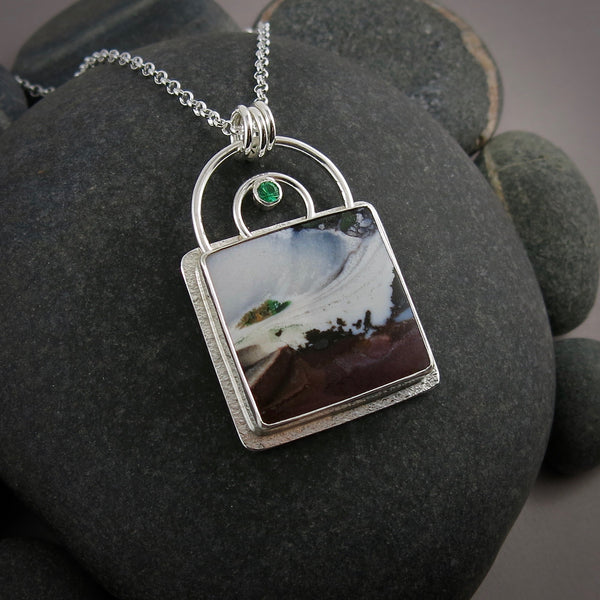
1. Opalized Petrified Wood
Opalized petrified wood, a mesmerizing fusion of geological wonders, originates from various locales, notably Arizona, USA, Indonesia, Mexico and Brazil. Formed over millions of years, this exquisite gemstone results from the gradual replacement of wood by vibrant opal deposits. The wood's organic structure is transformed into a kaleidoscope of colours, showcasing nature's artistry frozen in time. The intricate play of colours within these gemstones, ranging from vibrant reds to brilliant blues and greens makes opalized petrified wood a stunning centrepiece for jewellery. As wearable slices of ancient forests frozen in time, these gems not only evoke awe for Earth's history but also infuse every piece with a mesmerizing natural allure.
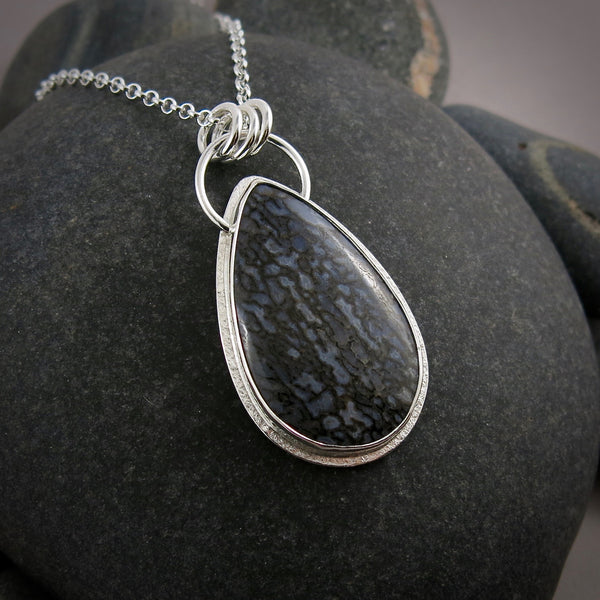
2. Dinosaur Bone
Dinosaur bone, with its intricate patterns and unique texture, carries the essence of prehistoric eras.
Dinosaur bone fossilization begins with the burial of bone in sediment layers. Over time, minerals from groundwater seep into the bone's pores, gradually replacing organic material with minerals like agate or quartz. This mineralization process preserves the bone's structure, transforming it into a durable fossilized relic of prehistoric times.
Its intriguing organic patterns and hues of deep reds, earthy browns and pale blues make it a sought-after material for bold and distinctive jewellery pieces, each carrying a piece of ancient history within.

3. Fossil Coral
Fossilized coral, formed through the replacement of coral by minerals over millions of years of oceanic history preserves the delicate structures and intricate patterns of ancient coral reefs. The amazing natural colours and intricate designs make fossil coral a versatile gemstone for jewellery, invoking a sense of underwater wonder and a connection to the ocean's history.
Agatization of Fossil Coral
When coral becomes agatized (not all fossil coral is agatized), the process begins with silica-rich water seeping through porous coral remains. Over time, the silica precipitates and replaces the coral's organic matter, preserving the intricate structures while infusing the gemstone with the vibrant properties of agate. This metamorphosis not only fossilizes the coral but enhances its durability, creating a timeless gemstone that stands the test of millennia.
A Kaleidoscope of Fossil Coral Colours: From Pinks to Browns to Vibrant Reds
Fossil coral boasts a diverse palette of colours, each hue reflecting the unique mineral impurities present during the fossilization process. From delicate pinks to warm browns and vibrant reds, the spectrum of colours in fossil coral is a testament to the diverse environments in which these corals thrived millions of years ago.
-
Soft Pinks: Delicate and feminine, pink-toned fossil coral evokes a sense of elegance. The subtle hues offer a timeless charm, making it a popular choice for understated yet sophisticated jewelry pieces.
-
Earthy Browns: Fossil coral in shades of brown exudes warmth and earthiness. The interplay of brown tones often reveals the intricate details of the coral's original structure, adding depth and character to the gemstone.
-
Vibrant Reds: The fiery allure of vibrant red fossil coral captures attention and conveys a bold statement. This intense colouration is often prized for creating eye-catching and dramatic jewelry pieces.

4. Ammolite
Ammolite, the dazzling gemstone revered for its iridescent beauty, emerges from the fossilized remains of ammonites, ancient marine creatures that lived over 65 million years ago. Through a process called mineralization, the original aragonite shells of the ammonites underwent transformation over millennia. As the shells fossilized, layers of sedimentary minerals, including calcium carbonate, infused the organic material. Over time, intense pressure and heat crystallized these minerals, creating the luminous iridescence characteristic of ammolite. Iridescence is caused by the diffraction of light on the layers of the gemstone.
This stunning gemstone captures the essence of ancient oceans, offering wearers a vibrant spectrum of colours that shimmer and shift with every movement.
Due to its rarity, ammolite is a highly sought-after gemstone, with only a few select locations worldwide yielding gem-quality specimens, including one of the most renowned, the Bearpaw formation in Southern Alberta, Canada. Its limited availability, combined with the intricate process of formation spanning millions of years, contributes to its exclusivity and commanding price tag, making it a prized investment for collectors and enthusiasts alike.

5. Ammonite
The ammonite itself, before transforming into ammolite, possesses its own charisma. Ammonites were ancient marine mollusks resembling modern-day nautiluses, with coiled shells and tentacle-bearing bodies. These fascinating creatures thrived in the oceans for millions of years before becoming extinct alongside dinosaurs.
The spiral-shaped shells of ammonites, fossilized over eons, display intricate chambers and detailed external patterns. In fact, the ammonite beautifully exhibits the mathematical poetry of the fibonacci sequence.
The Fibonacci sequence is a series of numbers where each is the sum of the two preceding ones (0, 1, 1, 2, 3, 5, 8, 13, and so on). The significance of the Fibonacci sequence in ammonite shells goes beyond mere mathematical elegance; it reflects the inherent order and balance in nature. The sequence has been associated with the concept of the "golden ratio" or "divine proportion." This ratio, often represented by the Greek letter Phi (Φ), is approximately 1.618 and is believed to convey a sense of aesthetic perfection and balance.
As we gaze upon the spiraled chambers of an ammonite, we witness a natural embodiment of this divine proportion. The growth of each chamber in relation to the others follows the golden ratio, creating a sense of visual harmony that resonates with our innate sense of beauty. It's as if nature, in its artistic expression, adheres to a sacred geometry that elicits a profound sense of balance and proportion.
This sequence appears not only in the spirals of ammonite shells but also in the arrangement of leaves, petals, the branching of trees, certain seashells and even spiral galaxies. It's a universal language that resonates across various forms of life, underscoring the interconnectedness of all living things.
While not as vividly colourful as ammolite, ammonites offer a sense of ancient mystique and natural elegance in jewellery design, often used as statement pieces.
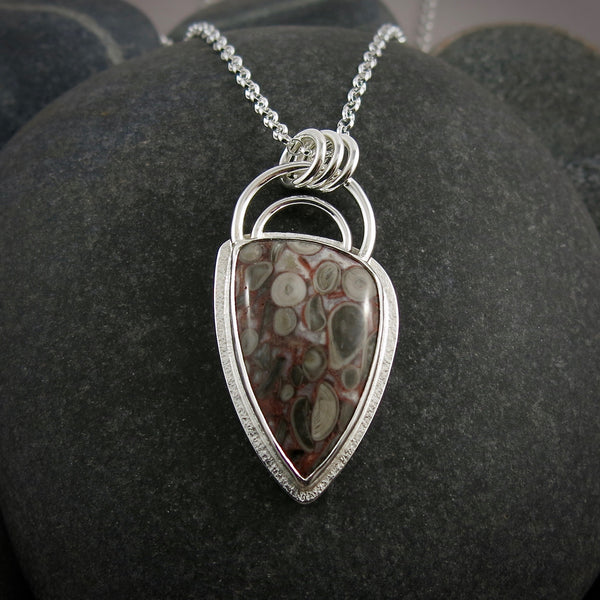
6. Fossil Sea Lily (Crinoid Jasper)
Fossil sea lily, formed from the remains of crinoids—marine animals resembling flowers—captivates with its intricate designs and earthy colours. The fossilized imprints of these creatures create stunning patterns within the gemstone, making it a unique and distinctive choice for jewellery.
Its blend of historical significance and natural beauty adds an intriguing element to any jewellery collection.
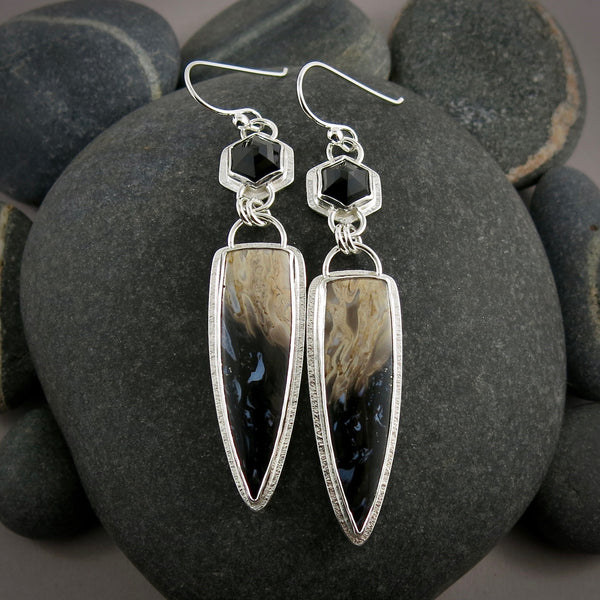
7. Fossil Palm Wood
Fossilized palm wood, transformed by minerals over eons, boasts intricate patterns resembling wood grain, making it a captivating gemstone.
Fossil palm root/wood forms through a process called permineralization, where organic material is gradually replaced by minerals over time. In ancient tropical landscapes, palm trees became buried under sediment layers, and minerals seeped into the wood, preserving its structure and creating stunning fossilized specimens that capture the essence of prehistoric forests.
Fossil palm wood exhibits a captivating array of colours, ranging from earthy browns to striking blacks and even pale blues. While the earthy browns and striking blacks are primarily due to the presence of minerals like iron oxide and carbon, the pale blues are more intriguing. The blue colouration in fossil palm wood is often caused by the presence of minerals such as celadonite or glauconite, which contain trace amounts of copper. Over millions of years, copper-rich groundwater infiltrates the porous wood, imparting a subtle blue hue. This unique colouring adds a touch of ethereal beauty to fossil palm wood, making each piece a stunning testament to the wonders of geological history.
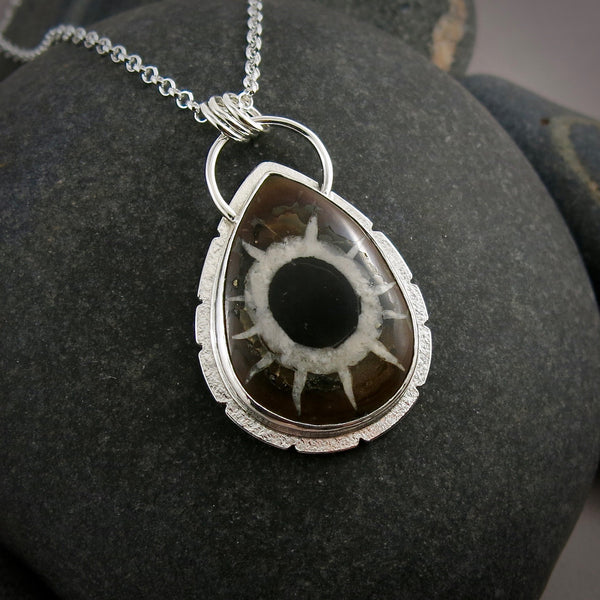
8. Septarian Fossil
Septarian fossils, also known as septarian nodules or dragon stone, are geological marvels formed millions of years ago. These unique formations originate from ancient seabeds, where mud balls containing organic matter and minerals underwent a transformative process. Over time, as the organic material decomposed, minerals such as calcite, aragonite, and barite filled the cracks, creating striking patterns of angular cavities known as septaria. These septarian nodules often exhibit a strikingly distinctive combination of colours and geometric patterns, making them prized specimens for collectors.
Why Wear Fossil Gemstone Jewellery?
-
Uniqueness: Fossil gemstones offer unparalleled uniqueness. Each stone carries a distinct pattern, colouration, and history, ensuring that every piece of jewellery is truly one-of-a-kind.
-
Connection to History: Wearing fossil gemstone jewellery is like wearing a piece of history. It connects us to ancient worlds and geological epochs, sparking curiosity and fascination.
-
Conversation Starters: These gemstone pieces provoke interest and conversation. The fusion of ancient elements with modern designs results in artistic and captivating jewellery pieces. They not only serve as adornments but also invite discussions about Earth's history and evolution.
-
Symbolism: Beyond their aesthetic appeal, fossil gemstone jewellery carries symbolic meanings—timelessness, resilience, and the beauty of evolution—adding depth to their allure.
Fossil gemstones, with their rich history and inherent beauty, make extraordinary additions to jewellery. They not only serve as stunning adornments but also as gateways to ancient epochs, inviting us to marvel at the passage of time and the wonders of our planet's geological heritage. Whether it's opalized petrified wood, dinosaur bone, fossil coral, ammolite, ammonite, or fossil sea lily, each gemstone tells a unique story spanning millions of years, and their rarity adds a profound charm to any jewellery piece they adorn.

